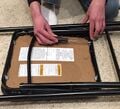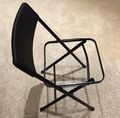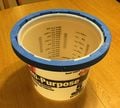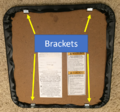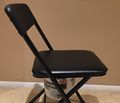Sophivorus (talk | contribs) m (Text replacement - "{{OpenKnowHowManifest" to "{{Device") |
mNo edit summary |
||
| Line 15: | Line 15: | ||
|manifest-language=eng | |manifest-language=eng | ||
|documentation-language=English | |documentation-language=English | ||
|countries-of-design=Category:United States | |||
|main-materials=Plastic | |main-materials=Plastic | ||
|estimated-cost-amount=19.07 | |estimated-cost-amount=19.07 | ||
Revision as of 12:06, 17 September 2020
Folding Chair Commode with Parametric 3D-Printed Bucket Holder
Project developed by Blgregor
Template:Statusboxtop Template:Status-design Template:Status-prototype You can help Appropedia by contributing to the next step in this OSAT's status. Template:Boxbottom
Abstract
The combination of disability and poverty creates a sanitation nightmare. Over 40% of the world lacks access to sanitary toilets [1]. In addition, over 500 million people are disabled, and most of these people live in poverty [2]. People whose mobility is impacted by injury, disease, or disability can not squat over a pit dug in the ground or walk to the nearest outhouse. In response to this problem, Jones and Reed [2] introduced the commode, which Oxfam defines as "a chair, which has a seat with a hole in it" [3]. A disabled person can sit in these chairs normally, remove the seat to expose a bucket as a toilet, and dispose of excrement by removing the bucket. Compact, cheap commodes could be used in disaster relief operations, hospitals, and households. Tests in Pakistan showed that commodes were hygienic (because they only had one user) and improved family life as the disabled person did not have to be carried to the community latrine every time he or she wanted to use the bathroom [3]. This page discusses how to build a commode for under $20 using a folding chair, bucket, Velcro (or rope, twine, etc), and a 3D-printed ring to hold the bucket. Please reach out to me with any suggestions or questions.
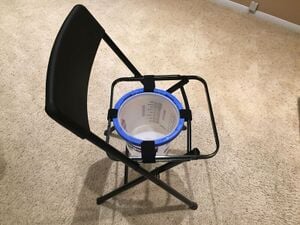
Bill of Materials
- Padded Folding Chair
- $12.25 here
- A different chair may be used, but the frame must travel all the way around the seat to allow for the bucket to be placed inside of it.
- Three feet of 1.5 inch self-gripping velcro
- $0.71/ft here or $2.13 total
- Alternates include duct tape, rope, or twine. These must be pulled taught and bear the weight of a human sitting on the 3D printed ring.
- Eight M4 x 12mm screws
- $0.08/screw here or $0.64 total
- One 8.5 inch diameter bucket (typically 5 quart or 1.5 gallon)
- $1.49 here
- If you change the bucket size, you will need to change the diameter of the ring in OpenScad and alter the Velcro lengths.
- If the bucket has a handle, the handle must be removed or accounted for in the 3D-printed ring.
- Eight 3D-printed ring components
- Open-Scad: File:Benjamin Gregory Commode Ring.scad
- STL on YouMagine
- 16 g of PLA or $0.32/piece (assuming $20/kg of filament), or $2.56 total
Tools needed for fabrication of the OSAT
- MOST Delta RepRap or similar RepRap 3-D printer
- Phillips head screwdriver for M4 screws and any screws securing the seat to the folding chair
Skills and Knowledge Necessary to Make the OSAT
- Knowledge of operating and troubleshooting a 3D printer
Technical Specifications and Assembly Instructions
- Print time: 1 hour/part or 8 hours total
- Assembly time: 10 minutes
- Remove the seat from the folding chair frame using an appropriate screwdriver (figure 2).
- Measure the length of the bucket and the gap in the chair frame. Adjust the OpenScad code so that the 3D-printed ring will hold the bucket in place and fit in between the chair frame (the chair frame is shown in figure 3).
- Print eight ring pieces (one piece is shown in figure 4). My settings included:
- PLA at 175 C
- 0.2 mm resolution with 2 mm walls
- 15% grid infill
- 5 top layers and 4 bottom layers
- 2-line skirt
- 90 mm/s infill, 70 mm/s inner walls, 40 mm/s outer walls, and 60 mm/s top and bottom layers
- Connect the eight ring pieces by threading M4 screws into the holes (figure 5).
- Place the bucket in the ring (figure 6).
- Use properly-sized Velcro strips to connect the ring to the chair frame (figure 7).
- Place the bucket in the ring and the seat on top of the bucket. The seat should fit snugly into the frame. Some seats include metal brackets that can be used to temporarily secure the seat to the frame (figure 8). The completed commode is shown in figures 9 and 10.
- To use:
- Lift the patient needing to use the toilet up and remove the seat.
- Place the patient back on the ring and allow them to use the toilet.
- Lift the patient up, remove the bucket, and replace the seat.
- Discard the contents of the bucket in a sanitary way, wash the bucket, and replace it.
- Assembly of Commode
-
Figure 2. Unscrewing the seat from the frame
-
Figure 3. Chair frame
-
Figure 4. Single 3D-printed ring piece
-
Figure 5. Assembling the ring
-
Figure 6. The assembled bucket and ring
-
Figure 7. Velcro slipped between the ring that is about to be wrapped around the frame
-
Figure 8. Metal brackets on seat
-
Figure 9. Completed commode with seat in place
-
Figure 10. Completed commode without seat in place
Common Problems and Solutions
- Ensure that the ring is sized so that the ring supports the bucket but a user does not have to exert significant force to remove the bucket. The bucket must be easily removed and replaced.
Cost savings
- Costs
- Chair: $12.25
- Velcro: $2.13
- Screws: $0.64
- Bucket: $1.49
- Filament: $2.56
- Total: $19.07
- Equivalent commercial commode in the Oxfam Equipment Catalogue for £45 or $49.61.
- Total cost savings of $30.54 or a 61.56% cost reduction
Benefited Internet Communities
This product has not been used yet, but could benefit the following groups:
- Field Ready [1]
- The International Red Cross [2]
- All Hands and Hearts [3]
- ShelterBox [4]
- International Medical Corps [5]
References
- ↑ "8 Toilet Designs That Could Save Millions of Lives Around the World," inhabitat (2015) Available: https://inhabitat.com/8-toilet-designs-that-could-save-millions-of-lives-around-the-world/
- ↑ 2.0 2.1 H. Jones and B. Reed, Water and sanitation for disabled people and other vulnerable groups: Designing services to improve accessibility, WEDC, Loughborough University, UK (2005) Abailable: https://www.susana.org/en/knowledge-hub/resources-and-publications/library/details/2218
- ↑ 3.0 3.1 "Excreta disposal for physically vulnerable people in emergencies," Oxfam Technical Briefing (2017) Available: https://oxfam.app.box.com/s/qxmccj5jr1fs3r978y5kixqtbm6wztig
